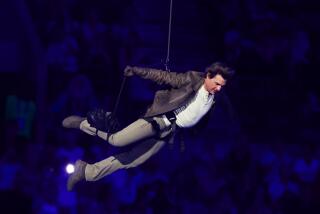TV Skating on Thin Ice : Commentary: Coverage of figure skating and ice dancing at the Winter Olympics illustrates how television manipulates our ideas about these disciplines.
- Share via
American television viewers saw their 1991 national women’s figure skating champion Tonya Harding fall at least five times during her performance Wednesday at the Winter Olympics in Albertville, France.
Of course, Harding actually fell only once, but between replays, recaps, interview segments and other videotape-recycling formats used by CBS-TV in its coverage, this accomplished, unlucky young athlete ended up hitting the ice nearly as often as the accident-prone skater impersonated by Jason Priestley on last week’s “Saturday Night Live.” Who remembers anything else about her performance?
The remarkably virile and imaginative skating of Canadian gold-medal favorite Kurt Browning also became reduced to this kind of video graffiti after he fell in the men’s competition last week. And the process illustrates one way that television radically manipulates our concepts of skating.
When you watch figure skaters or ice dancers in person at the rink, you see people hurtling toward and past you, with only the boldest changes in body-position and choreographic pattern registering to the stadium audience.
On television, however, the use of sophisticated follow-focus and image stabilization technology leaves the skaters magically suspended in the middle distance against a moving background.
This trick of the lens (and of the editing console) makes every small or incremental motion and facial expression in a skater’s performance just as vivid as the showiest turning/jumping combinations--or the actions of artists from the world of ballet, jazz and modern dance.
Last week, at the beginning of their drive toward an Olympic gold medal, Russian world champion pairs skaters Natalia Mishkutenok and Artur Dmitriev put the “Don Quixote” pas de deux on ice, turning the familiar 19th-Century ballet showpiece by Marius Petipa into a gymnastic skating routine wrapped in the style of Russian classicism.
On television, with the couple’s movement through space neutralized by fluid camera work, the sustained tests of the woman’s balance that always dominate the “Don Q” adagio made you compare Mishkutenok less to her skating competitors than to the Makarovas, Kirklands and Plisetskayas who have owned the role of Kitri onstage.
Similarly, the television illusion of skating as dance highlighted the extraordinary sense of flow (through the body as well as through compulsory feats) in the skating of American silver medalist Paul Wylie. Watching Wylie stretch a position for maximum linear eloquence and simultaneously fill it with feeling made both his Olympic performances memorable--but how much of that intimate, moment-to-moment sensitivity could be glimpsed from the stands?
In a sense, what the judges and 9,000 spectators saw in Albertville is irrelevant or, at best, mere raw material for the recontexualized tele-version watched by well over 100 million people. Since even the skaters themselves evaluate their achievements by checking the tube, everyone’s expectations and ambitions have changed over the years to incorporate TV realities.
Indeed, ice dancing itself is an artifact of the TV era, becoming an Olympic event only in 1976 and growing ever more confused about its identity. From a dance perspective, ice dancing in Albertville seemed very much a retreat from the glory days of Torvill and Dean, when the bonds of sport seemed about to crack and--Lord help us--a mass televised art form waited to be born.
This year, even mavericks sacrees Paul and Isabelle Duchesnay of France played it safe, though they couldn’t entirely hide their smoky intensity from the camera.
Their best moment may have come at the end of the compulsory blues routine on the first night of ice-dance competition, with Paul D. stroking his hair and projecting enough feral attitude to melt the Alpine snowcap while Isabelle D. slowly sank to the ice and leaned her head back against his leg with something more than sisterly ardor.
Whatever it looked like in Albertville, the final performance by Russian ice dancing gold medalists Sergei Ponomarenko and Marina Klimova reached CBS viewers as a series of ravishing, close-up TV images. Throughout, we seemed just inches away from Klimova’s glorious pre-Raphaelite hair, those sustained low lifts with Ponomarenko holding her parallel to the ice, the passionate kiss at the end. And of course we all bought the idea that the performance represented some kind of docudrama based on their relationship. But does anybody remember any skating?
Although network television utterly ignores concert dance, it has turned figure skaters and ice dancers into the mainstream equivalents of the icons of MTV hip-hop. Along the way, however, it assumed the right to bestow penalties and rewards on a scale that no Olympic judge can match.
Whether it’s those endless, devastating clips of Harding’s fall from grace or that enlarged golden smooch between Klimova and Ponomarenko, these televisionary penalties and rewards have drastically reshaped perceptions not only about individual artists and athletes but art and sport itself. The ice may belong tonight to Kristi Yamaguchi, but her image and place in Olympic history can be modified by CBS at the touch of a button.
More to Read
Go beyond the scoreboard
Get the latest on L.A.'s teams in the daily Sports Report newsletter.
You may occasionally receive promotional content from the Los Angeles Times.






